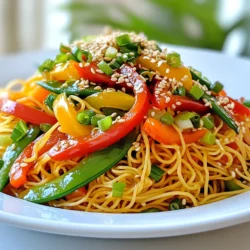
Sizzling Rainbow Vegetable Chow Mein
A colorful and flavorful vegetable stir-fry with noodles, perfect for a quick meal.
Ingredients
- 200 g egg noodles or your choice of noodles
- 1 tablespoon sesame oil
- 1 tablespoon vegetable oil
- 2 cloves garlic, minced
- 1 tablespoon ginger, grated
- 1 unit red bell pepper, sliced
- 1 unit yellow bell pepper, sliced
- 1 unit carrot, julienned
- 100 g snow peas, trimmed
- 150 g bean sprouts
- 4 unit green onions, chopped
- 3 tablespoons soy sauce
- 1 tablespoon oyster sauce or mushroom sauce
- 1 teaspoon sugar
- to taste salt and pepper
- for garnish sesame seeds
Instructions
- Bring a pot of water to a boil and cook the noodles according to package instructions until al dente. Drain and set aside.
- In a small bowl, mix together soy sauce, oyster sauce, and sugar. Set this sauce aside.
- In a large wok or skillet, heat the sesame oil and vegetable oil over medium-high heat. Add minced garlic and grated ginger, stir-frying for about 30 seconds until fragrant.
- Add the sliced red and yellow bell peppers, julienned carrot, and snow peas to the wok. Stir-fry for about 3-4 minutes until the vegetables are slightly tender but still crisp.
- Add the cooked noodles into the skillet and pour the prepared sauce over. Toss everything together, ensuring the noodles and vegetables are well coated.
- Add bean sprouts and half of the chopped green onions, stir-frying for another minute to mix everything. Season with salt and pepper to taste.
- Remove from heat and transfer to a serving platter. Garnish with the remaining green onions and a sprinkle of sesame seeds.
Notes
Use mushroom sauce for a vegetarian option.